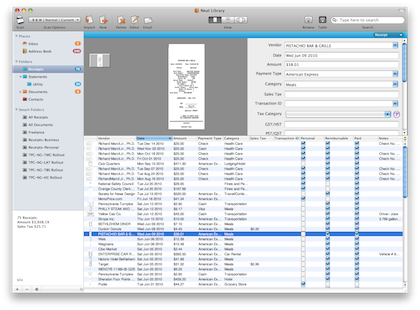Hardware Review
NeatReceipts and NeatWorks
NeatReceipts

Function: Scanner for receipts, business cards, and other small material.
Developer: The Neat Company
Price: $200 (list); $150-$175 (Amazon)
Requirements: Intel processor, Mac OS X 10.5.8, available USB port.
Recommended: 3 GB of RAM.
Trial: None
NeatWorks 3.0.8

Function: Software for scanning, OCRing, and filing scanned PDFs.
Developer: The Neat Company
Price: $80; free (bundled with NeatReceipts or NeatDesk scanners)
Requirements: Intel processor, Mac OS X 10.5.8.
Recommended: 3 GB of RAM.
Trial: None
It was love at first sight.
At first, I thought it was too good to be true. I even said as much during the demo. The NeatReceipts scanner is about length of a sheet of paper, and about the height and width of two iPhones. And it’s bus-powered, minimalist white with orange trim, and comes with a carrying case.
So I said to the lady at the Dulles Airport kiosk, “OK, hit me.” She seduced me with these glorious demos showing beautiful OCR and built-in types for receipts and business cards.
Little did I know what a tortured ride I was in for.
Here’s the pitch with the NeatReceipts scanner: portable, USB bus–powered scanner capable of easily pulling down letters, newspaper clippings, business cards, and receipts; and software to OCR, file, and categorize them. The demo I got—no thanks to boredom at the aptly-named Dulles—showed it effortlessly translating receipts into expense reports and business cards into contacts, and with only a little more work, turning clipped-out recipes from Cooking Light and the Washington Post into computerized, searchable text.

The pitch couldn’t have come at a better time for me, when I was really making a push to trim down my paper-based filing system and digitize everything. I’m pretty compulsive about my files—more on that later—and the old color-coded, labeled files were starting to eat up space I needed to store newer, more salient information. I was lost, hopeless, in spite of my organizational utopia. The NeatReceipts promised a way out.
Maybe this glorious pipe dream works just great on a PC. The demo sure was Windows-based. But when I got my little bundle of joy in the mail, plugged it in, and started scanning in receipts, I discovered the fatal flaw. The software, a dreadful piece of bloated crapusculence known as NeatWorks, is absolutely, 100 percent horrible.

Here is the litany:
It is painfully, excruciatingly slow. I have used it on my 2 GHz Core 2 Duo MacBook and on my brand-new 3.4 GHz i5 iMac, and although it’s borderline usable on the iMac, that’s not good enough. I shouldn’t be able to scan my receipts faster in Photoshop than in a piece of software whose principal job is OCRing text rather than high-fidelity photographic work.
The filing capabilities are surprisingly limited. It supports just three types of documents, each of which has its own set of supported metadata: Receipts, Documents and Business Cards. If something doesn’t fit neatly into the Receipts category, like bank statements or electric bills, they have to go in Documents…and the metadata that is supported for documents is only slightly better than not having any metadata at all.
There’s certainly no support for one of the things I file most: bills. I’m the kind of data-driven pack rat who keeps electric bills going back to when I first moved to Florida, in 2006, just to monitor my electric consumption over time. I refuse to get rid of old bills just because they’re paid. You never know what you’re going to need them for (and I have proof of that theory, in the form of a stolen-identity scare a few years ago). But NeatReceipts put almost the entire burden of filing bills and statements on the filename.
The OCR turns out not to be as useful as I expected, at least not for its primary application (receipts). I should give credit where credit’s due and point out that that’s not really NeatWorks’ fault. I’d never really studied my receipts before, but I was now discovering that they vary hugely in format. NeatWorks can’t guess what the total is, or even attempt to itemize, if the receipt breaks from convention.
Apparently the NeatWorks database, on the Mac, has an arbitrary limit of 999 files, thanks to crappy programming. After that, you’re supposed to archive the database, I think. But I don’t think it’s that hard to support an arbitrarily large database. After all, Bare Bones has no such limit for Yojimbo, and ATPM editor extraordinaire Michael Tsai’s EagleFiler has no limit either. What kind of ridiculous limit is 999?
Adding insult to injury, it’s almost impossible to use the software after about 100 scans. It was borderline unusable on my MacBook, but taking the resources up a notch to the i5 iMac, it went from “cannot use” all the way up to “go make cup of coffee while waiting.” It reminded me of Photoshop 6 in OS X 10.1…and I don’t mean that in a good way.
To be fair to NeatReceipts, the scanner itself really is great. It’s swift, and because it’s a sheetfed scanner rather than a flatbed, you can plow very quickly through, say, enough receipts for six weeks of company-paid travel.

I have digitized several boxes of files already using my NeatReceipts scanner, a task that would’ve been totally unbearable with a flatbed scanner, in a matter of relative swiftness, roughly two months working for several hours on occasional weekends. It’s about as fast as my shredder, and the shredder I’m supposed to turn off after 10 minutes of continuous shredding. More on how I did that later, since I ditched NeatWorks about 100 pages in.
So I have a lot of positive things to say about the NeatReceipts scanner…as long as I’m not using NeatWorks, that is.
Positives: Quick scanning with good fidelity of text on documents with reasonable contrast (receipts, bills, account statements, business cards from relatively boring companies); sheet-fed scanner means you’re not constantly positioning and cropping documents; buttons on front of device actually work with Mac OS X drivers. (You would be surprised how often that’s not true!)
Negatives: Waste of money to to pay for bundled software; company support is mediocre; could really use some kind of click-sliding paper guide like ink-jet printers have to keep receipts and business cards scanning straight.
So all in all, I’m happy enough.
But I’ll wager there are a lot of similar, maybe even less-expensive scanners that don’t come bundled with crapware. For instance, the NeatReceipts scanner is actually a rebadged Plustek OpticSlim M12—or so I hear—and that’s even less expensive. Because the scanner is TWAIN-compatible, you don’t really need NeatWorks.
Now, do you remember I said that I’d given up on NeatWorks, but that I was still using my scanner to digitize my files? Here’s a point of contention: everyone has a favorite file-database application. I ended up using DEVONthink Pro Office, which is excruciatingly expensive but has excellent and reasonably fast OCR support. Without getting into a full-scale review (maybe that’s for next month) it could benefit from more extended metadata, especially adding custom metadata columns the way I did. I decided not to use EagleFiler or Yojimbo for this task because of the OCR question. And I like DEVONthink, in spite of the expense.
Now it’s time to do some comparison shopping: You can find the OpticSlim M12 for about $120, and if you see the NeatReceipts for a similar price, it’s not a bad deal. But I certainly wouldn’t pay retail for it, because you’ll spend at least $50 on software. If you don’t mind spending more, the DEVONthink Office Pro bundle with the Fujitsu ScanSnap S1500 is probably the most bullet-proof solution.
So I think the moral of the story is, if you can get a good deal on the scanner, go ahead and get it. But be prepared to bring your own software.

Reader Comments (0)
Add A Comment